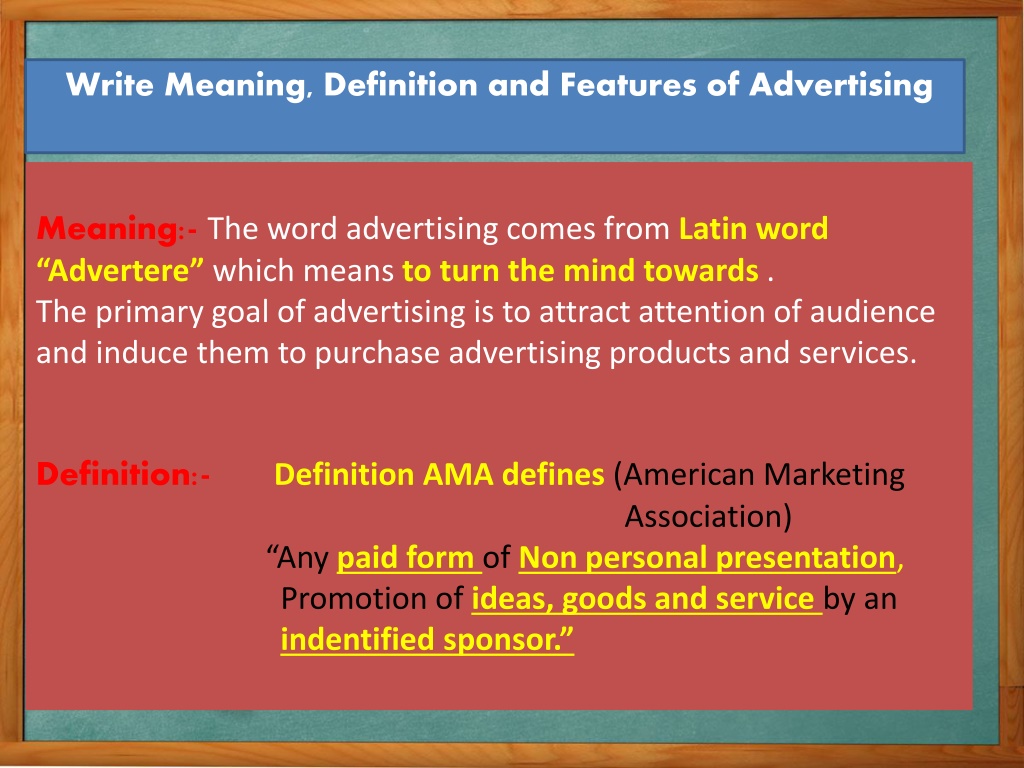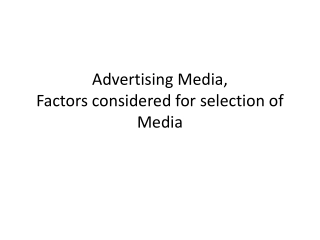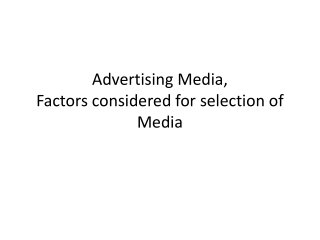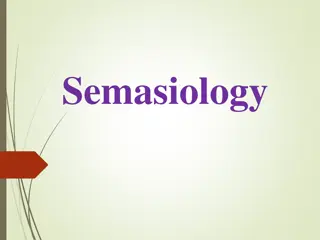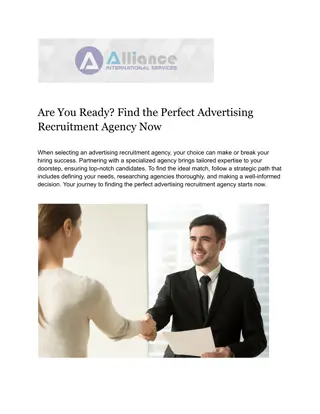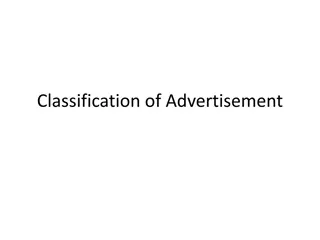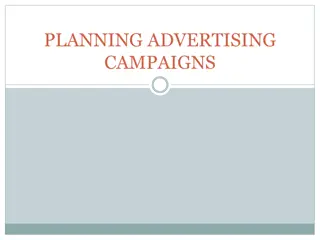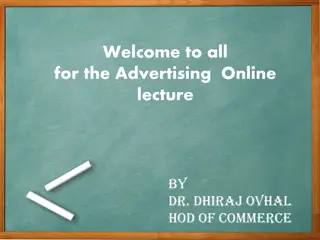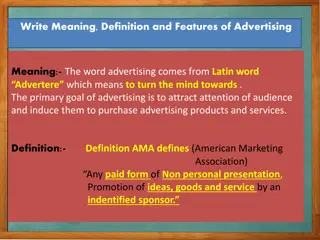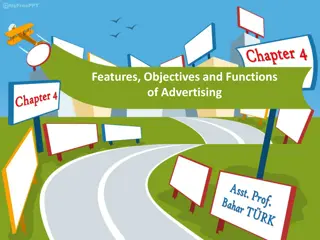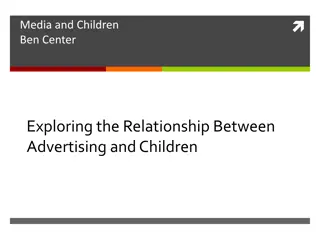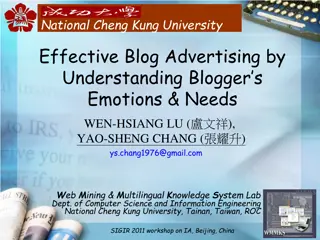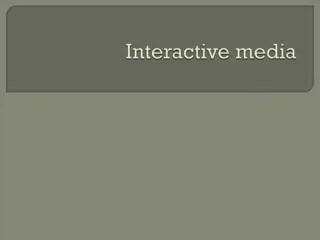Understanding Advertising: Meaning, Definition & Features
Advertising, derived from the Latin word "Advertere," aims to capture audience attention and persuade them to buy goods or services. It involves paid non-personal presentations to promote ideas, products, or services. The AIDA model (Attract Attention, Arouse Interest, Create Desire, Secure Action) guides advertisers in engaging with their target audience effectively through various methods like attractive headlines, captivating illustrations, bold letters, size, and position of ads.
Download Presentation

Please find below an Image/Link to download the presentation.
The content on the website is provided AS IS for your information and personal use only. It may not be sold, licensed, or shared on other websites without obtaining consent from the author. Download presentation by click this link. If you encounter any issues during the download, it is possible that the publisher has removed the file from their server.
E N D
Presentation Transcript
Write Meaning, Definition and Features of Advertising Meaning:- The word advertising comes from Latin word Advertere which means to turn the mind towards . The primary goal of advertising is to attract attention of audience and induce them to purchase advertising products and services. Definition AMA defines (American Marketing Definition:- Association) Any paid form of Non personal presentation, Promotion of ideas, goods and service by an indentified sponsor.
Welcome to all for the Advertising Online lecture Chapter 4- Brand building and Special Purpose of Adverting By dr. Dhiraj Ovhal HOD of Commerce
Q.2 AIDA Model? Meaning:- It was given by E. K. Strong in his book The psychology of Selling the AIDA formula stands for A---- Attracting Attention I----- Arousing Interest D---- Creating Desire A---- Securing Action
1. ATTRACTING ATTENTION: The primary purpose of any ad is to attract the attention of the audience. The headline and the illustration are the two important elements of an ad that attract the attention of the readers. Attention can be attracted in several ways. The different methods of attracting attention are listed as follows: a) Attractive Headline: The headline usually states the ad's central idea, elicits an emotion, or poses a question. It must attract attention and develop b)Beautiful Illustration: Natural Scenes/ Wild life: Natural scenes such as landscapes and wild life like lions, tigers, birds and even domestic animals like cats and dogs attract the attention of the readers. c)Personalities: When you are walking down a busy road you see so many others also walking along the road, but your eye sight may gaze on a beautiful face or someone known to you. In the same way popular personalities do attract attention of the readers. (iv) Motion: Printed ads expressing some kind of action like excitement, happiness attracts attention.
d) Bold Letters: Bold letters often attract attention. Look at the headlines on the front page of the newspaper. They are the lines that attract your attention when you glance over the newspaper. e) Size of the ad: Generally, the larger the size of the ad, the more it has the attention attracting value. At times, small is beautiful, especially, if the ad is properly presented and placed among all large ads. f) Position: The ads on the back page, center page and on the pages near the editorial content/index are definitely costly as
2. AROUSING INTEREST: Once the attention is attracted the ad should arouse interest in the mind of the readers to read the advertising message and slowly develop an interest toward the product that is advertised. This can be done by effectively drafting an interesting copy, exploiting the buying motives of the prospects and emphasizing the selling points of the product The advertiser can exploit such buying motives such as: Love and affection. Pride and Possession. Comfort and Convenience. Sex and Romance, etc. The advertiser should exploit buying motives by making use of the selling points such as: Special features of the product. Uses of the product,
3. CREATING DESIRE: The advertising copy usually expands on the idea of the heading, and illustration and provides facts and anticipates action on the of the readers. The objective is to create desire for the product desire can be created in the following ways: Highlighting product's special features and uses. Presenting negative effects for not using the product Showing proof of performance. Giving guarantee / warranty Money back guarantee. Offers like trial, discount, free gifts. Use of testimonials from reputed personalities. Effective after-sale-service. Emphasizing manufacturer's reputation, etc.
4. SECURING ACTION: The ultimate purpose of the ad is to secure a favourable response or action on the part of the readers. An effective ad is the one that moves the prospect to some action, usually a purchase. The desire created by the ad should generate into action. This can be done in the following ways: a) The ad should provide necessary instructions as to the availability of the product and other specific instructions . b) The ad should end on an active note, such as 'Get one today'. 'Contact your nearest dealer, today', 'Hurry up, the last date. ....Don't delay', 'Order today', or such words or phrases that impel action
Attendance Link https://forms.gle/U4Da9ykpniL3tpCdA (Mention date at last point)
